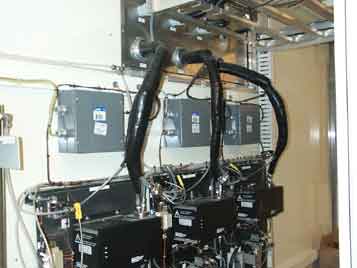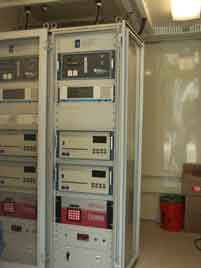The Continuous Emission Monitoring (CEM) Program
is responsible for the quality assurance of data generated
through the use of permit required CEMs at New Jersey
facilities. The goal of the program is to provide reliable,
accurate and dependable data to be used by NJDEP, the
public and industry.
 Continuous sampling generally
requires a heated samplingline
Continuous sampling generally
requires a heated samplingline
to bring a steady stream of stack gas down to
analyzer
equipment located at ground level. |
 In this example an analyzer
and
In this example an analyzer
and
data
recording equipment housed
in
a climate controlled environment
provide a continuous record of
contaminant levels
in the stack
exhaust of a permitted facility. |
Getting Started
When a facility is required to install a CEM, either
by its Air Permit, a regulation or as the result of
an enforcement action, oversight is provided by the
EMS. There are four main elements to the CEM approval
process:
- Equipment Protocol review and approval.
- Certification Test Protocol review and approval.
- Observation of the Certification test.
- Review of the final test report.
In most cases, a test consultant is contracted to prepare
the protocols, perform the test and submit the report.
Equipment Protocols
The equipment protocol is a source specific document
which details the proposed equipment to be included
in the CEM system. EMS reviews the equipment protocol
to ensure that the proposed equipment is capable of
providing reasonably accurate data. Deficiencies are
identified and must be corrected before EMS will approve
proceeding to the next step in the approval process.
Certification Test Protocol
The certification protocol is a source specific test
plan that details how the equipment, once installed,
will be initially tested for accuracy. It identifies
the test methods and performance specifications that
will be used, as well as how they will be adapted to
meet the source specific conditions. EMS reviews the
certification protocol to ensure that both the most
appropriate methods and performance specification were
proposed and that they are being applied properly to
the specific source. Deficiencies are identified and
must be corrected before EMS will approve initiating
the actual testing.
Scheduling a Test
Once both protocols have been approved, a mutually acceptable
test date is established. The certification test is
then conducted (sometimes with EMS oversight) to ensure
adherence to the protocol.
Final Report
Upon completion of testing, a final test report is prepared
and submitted to EMS for evaluation. The test report
must include copies of all raw field and laboratory
data so that EMS staff can verify that all procedures
were followed and can confirm the calculations of the
emissions results.
For More Information
For more detailed explanation of how one goes about
installing and certifying a CEM system, please download
Technical Manual 1005,(in .pdf
format), "Guidelines for Continuous Emissions
Monitoring Systems (CEMS) and Continuous Opacity Monitoring
Systems (COMS)".
To open the PDF documents you will
need the adobe acrobat pdf reader to view. Left-click
on the link and they will open. Or, right-click on the
link and select "Save Target As" to save the document
to your hard drive or personal directory. You can download
the free pdf reader here. |